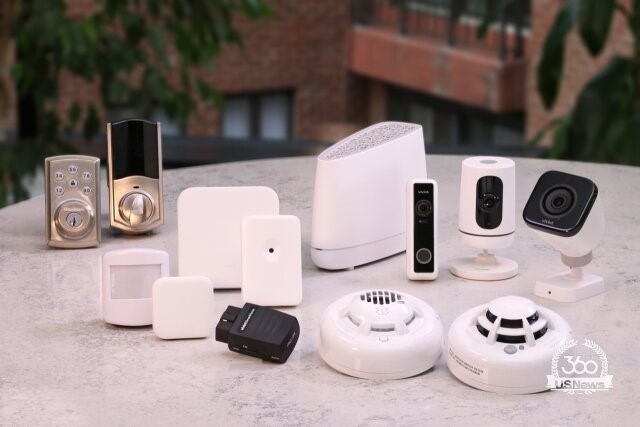Top Home Security Systems of 2024
Home security is an essential aspect of safeguarding your property, loved ones, and personal belongings. With advancements in technology, there are now a myriad of home security devices available on the market. In this article, we’ll explore the top home security devices, analyze their features, and compare their benefits to help you make an informed decision about which devices might best suit your needs.

Types of Home Security Devices
Home security devices come in various types, each serving a unique purpose. The main categories include:
- Surveillance Cameras
- Motion Detectors
- Door and Window Sensors
- Smart Locks
- Alarm Systems
- Video Doorbells
Surveillance Cameras
Surveillance cameras are pivotal in monitoring your property in real-time. They come in different types, such as:
- Indoor Cameras: Designed for monitoring interior spaces. Often used in conjunction with other security measures.
- Outdoor Cameras: Built to withstand weather conditions and provide coverage of external areas.
- Wireless Cameras: Offer flexibility in placement and are easy to install.
- Smart Cameras: Integrate with home automation systems and offer advanced features like motion detection and night vision.
Features and Benefits
- High Definition (HD) Resolution: Ensures clear and detailed video footage.
- Night Vision: Allows for monitoring in low-light conditions.
- Motion Detection: Alerts you when movement is detected, reducing false alarms.
Motion Detectors
Motion detectors are designed to sense movement within a specified area. They are crucial for detecting unauthorized entries.
Types
- Passive Infrared (PIR) Detectors: Detect heat changes in the environment.
- Ultrasonic Detectors: Use sound waves to detect movement.
- Microwave Detectors: Employ microwave pulses to sense motion.
Features and Benefits
- Adjustable Sensitivity: Customize the sensitivity to avoid false alarms.
- Wide Coverage Area: Monitors large areas for movement.
- Integration with Alarm Systems: Enhances the effectiveness of security systems.
Door and Window Sensors
These sensors are placed on doors and windows to alert you when they are opened. They are essential for detecting unauthorized entry points.
Features and Benefits
- Easy Installation: Typically adhesive, requiring no drilling or complex setup.
- Remote Alerts: Send notifications to your phone if a door or window is opened.
- Integration with Home Automation: Can be linked to other smart devices for comprehensive security.
Smart Locks
Smart locks provide enhanced security and convenience for your doors. They can be controlled remotely and offer various methods for entry.
Features and Benefits
- Remote Access: Lock or unlock doors from anywhere using a smartphone app.
- Keyless Entry: Avoid the hassle of physical keys with keypads, biometrics, or smartphone access.
- Audit Trails: Track who enters and exits your home and when.
Alarm Systems
Alarm systems are the backbone of home security, alerting you and authorities of potential breaches.
Types
- Monitored Systems: Connected to a professional monitoring service that alerts emergency responders.
- Unmonitored Systems: Trigger alarms and notifications but rely on the homeowner to respond.
Features and Benefits
- Loud Alarms: Deter intruders with loud, attention-grabbing sounds.
- Emergency Contacts: Notify local authorities or emergency contacts if a breach is detected.
- Customizable Alerts: Set up different alerts for various types of breaches.
Video Doorbells
Video doorbells allow you to see and communicate with visitors at your door through a video feed on your smartphone.
Features and Benefits
- Two-Way Audio: Communicate with visitors or delivery personnel remotely.
- Motion Detection: Alerts you to movement near your door, even if no one rings the bell.
- HD Video: Provides clear video footage of visitors and activities at your doorstep.
Analysis Table
The analysis table below summarizes the key features, benefits, and considerations of each type of home security device.
| Device Type | Key Features | Benefits | Considerations |
| Surveillance Cameras | HD Resolution, Night Vision, Motion Detection | Clear footage, Monitoring in low light, Alerts on movement | Privacy concerns, Requires internet |
| Motion Detectors | Adjustable Sensitivity, Wide Coverage Area | Customizable detection, Enhanced security coverage | False alarms if not properly adjusted |
| Door and Window Sensors | Easy Installation, Remote Alerts | Simple setup, Real-time notifications | Limited to entry points, Battery life |
| Smart Locks | Remote Access, Keyless Entry, Audit Trails | Convenience, Enhanced security, Track access | Dependence on technology, Battery life |
| Alarm Systems | Loud Alarms, Emergency Contacts, Customizable Alerts | Immediate alerts, Professional monitoring | Potential for false alarms, Monthly fees for monitored systems |
| Video Doorbells | Two-Way Audio, Motion Detection, HD Video | Communication with visitors, Remote monitoring | Privacy issues, Requires good internet connection |
Comparative Table
The comparative table provides a side-by-side look at the main features of each device type to help in decision-making.
| Feature | Surveillance Cameras | Motion Detectors | Door and Window Sensors | Smart Locks | Alarm Systems | Video Doorbells |
| HD Resolution | Yes | No | No | No | No | Yes |
| Night Vision | Yes | No | No | No | No | No |
| Motion Detection | Yes | Yes | Yes | No | Yes | Yes |
| Remote Access | Yes (for smart models) | No | Yes (for smart models) | Yes | Yes (for monitored systems) | Yes |
| Keyless Entry | No | No | No | Yes | No | No |
| Two-Way Audio | No | No | No | No | No | Yes |
| Adjustable Sensitivity | No | Yes | No | No | No | No |
| Easy Installation | Depends on type | Yes | Yes | Yes | Depends on type | Yes |
| Requires Internet | Yes (for smart models) | No | Yes (for smart models) | Yes | Yes (for monitored systems) | Yes |
| Privacy Concerns | Medium | Low | Low | Medium | Low | High |
Conclusion
Choosing the right home security devices depends on your specific needs and preferences. Surveillance cameras offer detailed monitoring, motion detectors provide an additional layer of security, and door/window sensors protect entry points. Smart locks and video doorbells enhance convenience and communication, while alarm systems form the core of a comprehensive security strategy. Consider your home’s layout, your security needs, and your budget when selecting the best combination of devices to keep your property safe and secure.










